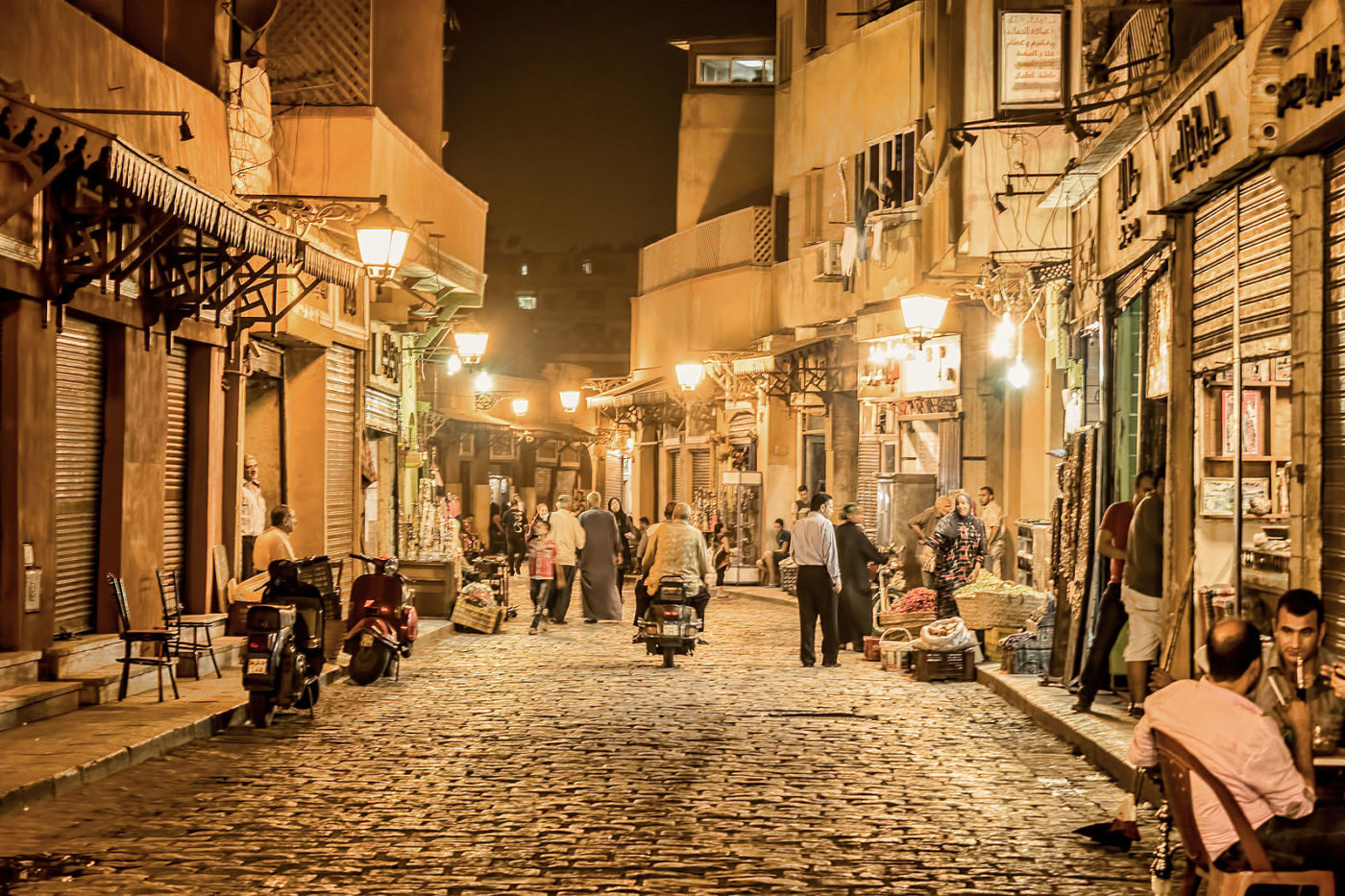Cairo doesn’t reveal itself all at once.
It’s a city that unfolds slowly — not in landmarks, but in gestures. A door left open. A shadow passing across a balcony. A smell of roasted corn that guides you through an unfamiliar street.
For newcomers, the city can feel impossible to navigate. Maps are useless; they can’t account for the rhythm of life that shifts daily. But that’s precisely the point — Cairo was never meant to be navigated. She was meant to be discovered.
“If you want to understand Cairo,” says Hany El Deeb, an antique seller on Mahmoud Bassiouny Street, “you must let her mislead you first.”
And so begins the art of getting lost.
1. Downtown Cairo: Where Memory Lives in Neon
Start your walk in Downtown Cairo, early enough that the air still carries the coolness of night. The city hasn’t yet remembered its own noise.
Here, every building tells a layered story — the balconies of Talaat Harb, the cracked marble of Cinema Radio, the ghost signs on walls that once read Pepsi-Cola in Arabic script.
You might pass Café Riche, one of Cairo’s oldest cafés, where writers and revolutionaries once argued over tea. Step inside; order Turkish coffee. The waiter, likely in his sixties, will call you “bey” with the same tone he used in the 1970s.
“Everyone who mattered in this city sat here once,” says Adel, the waiter with a trimmed mustache and a sharp memory. “Politicians, poets, lovers — now, mostly tourists. But the ghosts still listen.”
A few steps away, you’ll find Kodak Passageway, reborn as a creative hub after years of neglect. Here, Cairo Photo Week exhibitions hang on peeling walls, while students from the AUC School of Design sip espresso on concrete steps.
Between frames and laughter, Cairo feels young again.
Then, turn left toward Falaky Square, and you’ll stumble upon Townhouse Gallery — one of the few remaining art spaces that survived the years of uncertainty. If you’re lucky, the manager Maha will let you into the back room, where she keeps photographs from early exhibitions — the city before Instagram.
“Cairo’s problem isn’t that it changes,” Maha says. “It’s that it remembers everything.”
By noon, the streets begin to hum. The smell of diesel blends with jasmine from a flower seller weaving between cars. Musicians on Adly Street strum oud between honking taxis. You’re lost, but perfectly at home.
2. Zamalek: The Island of Stillness
Cross the Qasr El Nil Bridge, where lions guard the entrance with weathered grace. The Nile glints beneath, carrying years and cigarette butts alike.
Halfway across, stop. Turn back and look — the skyline behind you wavers in the heat like a mirage.
On the other side lies Zamalek, Cairo’s green island — a world apart. Wide streets, embassies, and cafes shaded by jacaranda trees. It’s the part of the city where Cairo exhales.
Your first stop should be Diwan Bookstore, a quiet refuge filled with English and Arabic titles, where expats browse Egyptian authors and locals read Murakami. The staff are patient — they’ll recommend Naguib Mahfouz before you even ask.
Just across the street, at Left Bank Café, writers tap on laptops beside the river. Order hibiscus iced tea and stay longer than you planned. The waiter will refill your glass without asking — an unspoken Cairo kindness.
Continue down 26th of July Street, past Zooba, Sami Amin Jewelry, and Cairo Kitchen. Each storefront tells a story of design meeting nostalgia.
If you wander off into the smaller lanes — Brazil Street, Bahgat Aly, Ismail Mohamed — you’ll find villas from another era. Some turned into galleries, some into silent ruins. On Brazil Street, look for Galerie Misr, where you might meet Karim, a young curator who hosts independent exhibitions.
He smiles when asked why he stays in Cairo.
“Because here, art feels like survival.”
At sunset, walk toward the edge of the island, to The Lemon Tree & Co. Order mint lemonade, watch the boats drift by, and let the golden light blur everything. Cairo looks softer from here — like she’s forgiven herself.
3. Old Cairo: Faith and Dust
No trip, lost or found, is complete without Old Cairo.
Take the metro to Mar Girgis Station, where the smell of incense greets you before you surface. Here, in Coptic Cairo, faith is architecture.
The Hanging Church floats above ancient pillars; Ben Ezra Synagogue stands quietly behind it, sunlight filtering through its lattice windows; and Amr Ibn Al-As Mosque, Egypt’s first, anchors it all.
“You don’t have to believe to feel it,” says Father Michael, a priest who has spent thirty years guiding visitors through the church. “You just have to listen.”
This part of the city is quieter, but it hums with an invisible energy. Between the churches and mosques, children chase pigeons across cobblestones. A nun buys bread from a Muslim baker. A tourist photographs both, unsure which story to caption.
If you keep walking south, you’ll find yourself in Fustat, where the Egyptian Museum of Civilization now houses royal mummies — the kings of old Egypt lying in dim, respectful silence.
A few hundred meters away, potters shape clay in workshops that have existed for generations. Their hands move with rhythm — the city’s oldest language.
“Clay remembers touch,” says Abdallah, a third-generation potter. “So does Cairo.”
4. The City as a Mirror
By now, you’ve probably gotten lost more than once. Google Maps will have failed you; taxis will have dropped you “near” your destination; and you’ll have walked further than intended. But that’s the point.
Cairo’s streets are built for discovery, not direction. They bend and contradict themselves like memory.
You’ll find contradictions everywhere: a crumbling cinema playing Netflix posters, a luxury boutique beside a street market, a Sufi shrine beside a nightclub.
And yet, somehow, it works. Cairo’s beauty lies in her contradictions — she allows opposites to coexist without apology.
“This city doesn’t ask you to choose between chaos and calm,” says photographer Reem Naguib. “She offers both, at the same time.”
Getting lost here isn’t failure; it’s a rite of passage. Each wrong turn introduces you to someone — a vendor who points you the right way, a child who laughs at your Arabic, a policeman who insists on offering directions twice.
At some point, you stop trying to find your way and start finding yourself.
5. A Lesson in Slowness
Cairo teaches you how to slow down. Not in leisure, but in presence.
You learn to measure time differently — by sunsets on the Nile, by the smell of roasted peanuts on a winter night, by the rhythm of the adhan echoing across neighborhoods.
By the time you leave, you’ll realize that every time you got lost, the city was teaching you something — about patience, humility, and wonder.
When you finally find your way back to the river, look across the water. Cairo isn’t a city that asks to be understood. She only asks to be felt.
And to feel her, you have to get lost first.




